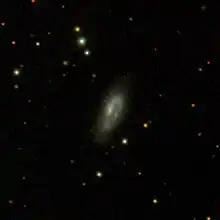| NGC 9 | |
|---|---|
 NGC 9 (Sloan Digital Sky Survey) | |
| Observation data (J2000 epoch) | |
| Constellation | Pegasus |
| Right ascension | 00h 08m 54.7s [1] |
| Declination | +23° 49′ 01″[1] |
| Redshift | 0.015104[1] |
| Heliocentric radial velocity | 4528 ± 10 km/s[1] |
| Distance | 142 ± 31 Mly (43.5 ± 9.5 Mpc)[2] |
| Apparent magnitude (V) | 14.35 [1] |
| Absolute magnitude (V) | —18.69 |
| Characteristics | |
| Type | Sb: pec [1] |
| Apparent size (V) | 1.3' x 0.7' [1] |
| Other designations | |
| UGC 78,[1] PGC 652 [1] | |
NGC 9 is a spiral galaxy about 140 million light-years away in the Pegasus constellation. It was discovered on 27 September 1865 by Otto Wilhelm von Struve.[3]

NGC 9 (near-infrared)
References
- 1 2 3 4 5 6 7 8 9 "NED results for object NGC 0009". National Aeronautics and Space Administration / Infrared Processing and Analysis Center. 2008. Retrieved 24 November 2008.
- ↑ "Distance Results for NGC 0009". NASA/IPAC Extragalactic Database. Retrieved 3 May 2010.
- ↑ Steinicke, Wolfgang (2010). Observing and Cataloguing Nebulae and Star Clusters. Cambridge University Press. p. 283. ISBN 9780521192675.
External links
 Media related to NGC 9 at Wikimedia Commons
Media related to NGC 9 at Wikimedia Commons- NGC 9 on WikiSky: DSS2, SDSS, GALEX, IRAS, Hydrogen α, X-Ray, Astrophoto, Sky Map, Articles and images
This article is issued from Wikipedia. The text is licensed under Creative Commons - Attribution - Sharealike. Additional terms may apply for the media files.